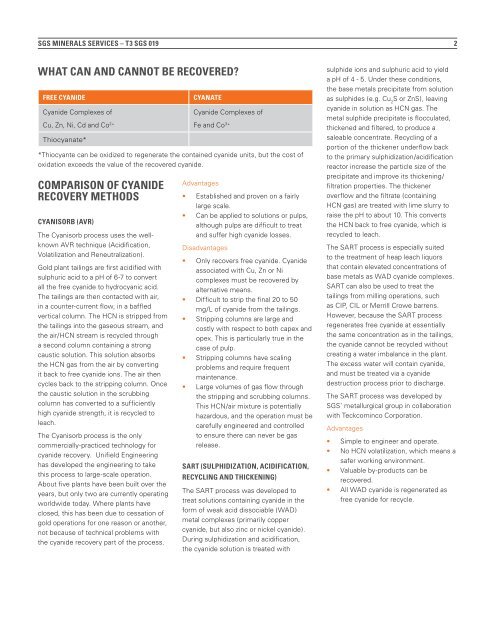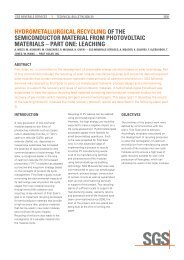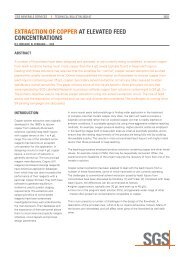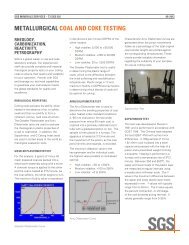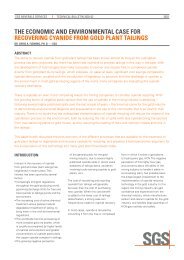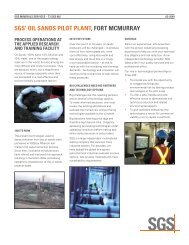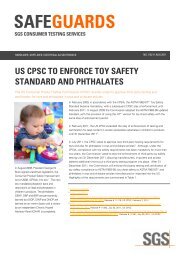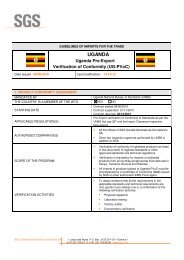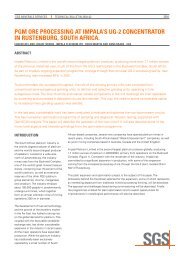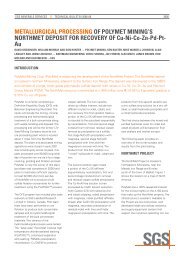You also want an ePaper? Increase the reach of your titles
YUMPU automatically turns print PDFs into web optimized ePapers that Google loves.
<strong>SGS</strong> MINERALS SERVICES – T3 <strong>SGS</strong> 019 2<br />
WHAT CAN AND CANNOT BE RECOVERED?<br />
FREE <strong>CYANIDE</strong> CYANATE<br />
Cyanide Complexes of<br />
Cu, Zn, Ni, Cd and Co 2+<br />
Thiocyanate*<br />
Cyanide Complexes of<br />
Fe and Co 3+<br />
*Thiocyante can be oxidized to regenerate the contained cyanide units, but the cost of<br />
oxidation exceeds the value of the recovered cyanide.<br />
COMPARISON OF <strong>CYANIDE</strong><br />
<strong>RECOVERY</strong> METHODS<br />
CYANISORB (AVR)<br />
The Cyanisorb process uses the wellknown<br />
AVR technique (Acidification,<br />
Volatilization and Reneutralization).<br />
Gold plant tailings are first acidified with<br />
sulphuric acid to a pH of 6-7 to convert<br />
all the free cyanide to hydrocyanic acid.<br />
The tailings are then contacted with air,<br />
in a counter-current flow, in a baffled<br />
vertical column. The HCN is stripped from<br />
the tailings into the gaseous stream, and<br />
the air/HCN stream is recycled through<br />
a second column containing a strong<br />
caustic solution. This solution absorbs<br />
the HCN gas from the air by converting<br />
it back to free cyanide ions. The air then<br />
cycles back to the stripping column. Once<br />
the caustic solution in the scrubbing<br />
column has converted to a sufficiently<br />
high cyanide strength, it is recycled to<br />
leach.<br />
The Cyanisorb process is the only<br />
commercially-practiced technology for<br />
cyanide recovery. Unifield Engineering<br />
has developed the engineering to take<br />
this process to large-scale operation.<br />
About five plants have been built over the<br />
years, but only two are currently operating<br />
worldwide today. Where plants have<br />
closed, this has been due to cessation of<br />
gold operations for one reason or another,<br />
not because of technical problems with<br />
the cyanide recovery part of the process.<br />
Advantages<br />
• Established and proven on a fairly<br />
large scale.<br />
• Can be applied to solutions or pulps,<br />
although pulps are difficult to treat<br />
and suffer high cyanide losses.<br />
Disadvantages<br />
• Only recovers free cyanide. Cyanide<br />
associated with Cu, Zn or Ni<br />
complexes must be recovered by<br />
alternative means.<br />
• Difficult to strip the final 20 to 50<br />
mg/L of cyanide from the tailings.<br />
• Stripping columns are large and<br />
costly with respect to both capex and<br />
opex. This is particularly true in the<br />
case of pulp.<br />
• Stripping columns have scaling<br />
problems and require frequent<br />
maintenance.<br />
• Large volumes of gas flow through<br />
the stripping and scrubbing columns.<br />
This HCN/air mixture is potentially<br />
hazardous, and the operation must be<br />
carefully engineered and controlled<br />
to ensure there can never be gas<br />
release.<br />
SART (SULPHIDIZATION, ACIDIFICATION,<br />
RECYCLING AND THICKENING)<br />
The SART process was developed to<br />
treat solutions containing cyanide in the<br />
form of weak acid dissociable (WAD)<br />
metal complexes (primarily copper<br />
cyanide, but also zinc or nickel cyanide).<br />
During sulphidization and acidification,<br />
the cyanide solution is treated with<br />
sulphide ions and sulphuric acid to yield<br />
a pH of 4 - 5. Under these conditions,<br />
the base metals precipitate from solution<br />
as sulphides (e.g. Cu 2 S or ZnS), leaving<br />
cyanide in solution as HCN gas. The<br />
metal sulphide precipitate is flocculated,<br />
thickened and filtered, to produce a<br />
saleable concentrate. Recycling of a<br />
portion of the thickener underflow back<br />
to the primary sulphidization/acidification<br />
reactor increase the particle size of the<br />
precipitate and improve its thickening/<br />
filtration properties. The thickener<br />
overflow and the filtrate (containing<br />
HCN gas) are treated with lime slurry to<br />
raise the pH to about 10. This converts<br />
the HCN back to free cyanide, which is<br />
recycled to leach.<br />
The SART process is especially suited<br />
to the treatment of heap leach liquors<br />
that contain elevated concentrations of<br />
base metals as WAD cyanide complexes.<br />
SART can also be used to treat the<br />
tailings from milling operations, such<br />
as CIP, CIL or Merrill Crowe barrens.<br />
However, because the SART process<br />
regenerates free cyanide at essentially<br />
the same concentration as in the tailings,<br />
the cyanide cannot be recycled without<br />
creating a water imbalance in the plant.<br />
The excess water will contain cyanide,<br />
and must be treated via a cyanide<br />
destruction process prior to discharge.<br />
The SART process was developed by<br />
<strong>SGS</strong>’ metallurgical group in collaboration<br />
with Teckcominco Corporation.<br />
Advantages<br />
• Simple to engineer and operate.<br />
• No HCN volatilization, which means a<br />
safer working environment.<br />
• Valuable by-products can be<br />
recovered.<br />
• All WAD cyanide is regenerated as<br />
free cyanide for recycle.


